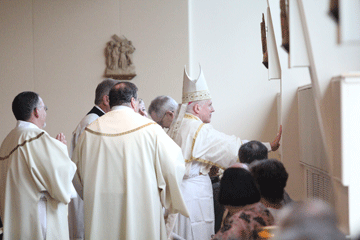When St. Genevieve Parish was founded in Flourtown in 1955 Archbishop John F. O’Hara was Archbishop of Philadelphia. A former president of Notre Dame University, he was really big on building schools, but not so much churches. St. Genevieve is a case in point.
Under the diocesan rules, a permanent church couldn’t be built until the school was paid for, so the solution was to build a combination church/school, which translated into a school with a rather nice ground floor auditorium. By the time the parish was in a position to build a free-standing church, construction costs were increasing, and many parishioners liked what they had.
[hotblock]
Father Michael Matz, pastor of St. Genevieve, along with his parish councils, decided something should be done. The best solution was to renovate the existing building to make it more church like.
It took $3 million and well over a year to accomplish, but the end product was worth it.
During the renovations, parishioners attended Mass at the former Seven Dolors Church in Wyndmoor, which is now a worship site for St. Genevieve, but it wasn’t large enough for the most attended Masses, which were held at the auditorium of Mount St. Joseph’s Academy.
Architects designing the renovations had to face several challenges, not the least of which was the relatively low ceiling, especially noticeable looking down the long center aisle. This was overcome through a gracefully curved ceiling design and lighting.
The church was gutted, and the altar is now situated at the center of the long side of the rectangular room. By doing this it was also possible to create a more intimate atmosphere by grouping the new pews in the 8,800 square foot, 500-seat church along three sides of the sanctuary that extends into an octagonal bay.
Sacred objects and art are a mixture of old and new, including a beautiful baptismal font brought over from Seven Dolors and a new marble altar.
Expanses of new stained glass and clear glass along with marble accents transform and brighten the interior.
Other features include new stone flooring, and the creation of an enlarged gathering space. Exterior treatment of the entrance walls help set the church apart from the school, as does an ornamental new cupola.
With almost all the renovations completed and the parishioners back in their church, the church was rededicated Sept. 10 by Auxilary Bishop Daniel E. Thomas.
“It looked very utilitarian; we made it look like a church,” Father Matz said.
PREVIOUS: Two archdiocesan schools earn blue ribbons
NEXT: Archbishop Chaput rededicates, blesses renovated St. Bede Church




Trying to find father Michael Matz that was our Decan at Holy Saviour in Linwood Pa.would love to come to church and visit with him its been at least 30 years
After moving out of the state for sometime, I came back to Flourtown to find my childhood parish totally different. Atleast 5 generations of my family have celebrated our sacraments at St. Genevieve. I myself was an altar boy and attended CCD at St. Gens. Following the death of my aunt, my grandparents donated the altar and liturgical hangings that told of the liturgical season. We attended mass only to realize that those items were no longer part of the Church. St. Gens had always been the home of the Augustinian Order and Parishoners of Our Mother of Consulation. I feel deeply hurt that our family was never reached out too or notified of these changes. We would have liked to have been part of the celebration or even asked where the items donated in my Aunt’s memory should be placed. I wish the parishoners and fathers all the best.